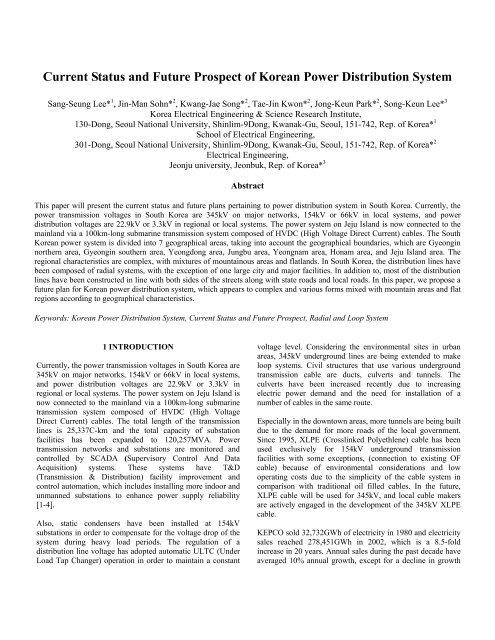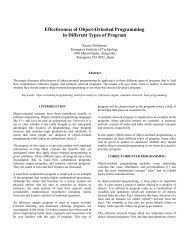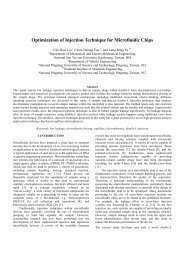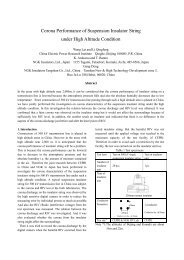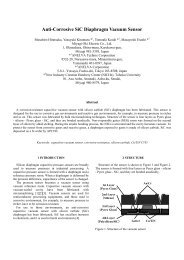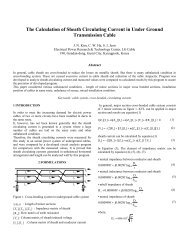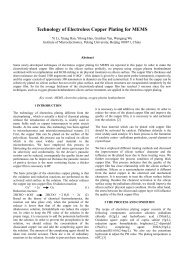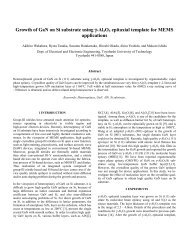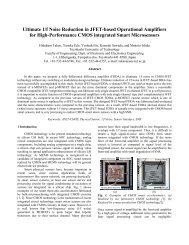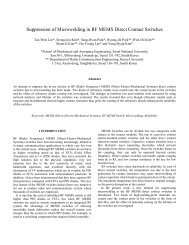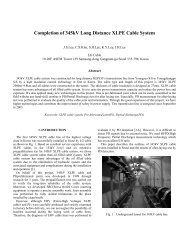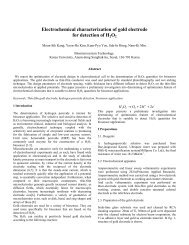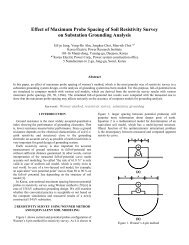Current Status and Future Prospect of Korean Power Distribution ...
Current Status and Future Prospect of Korean Power Distribution ...
Current Status and Future Prospect of Korean Power Distribution ...
- No tags were found...
You also want an ePaper? Increase the reach of your titles
YUMPU automatically turns print PDFs into web optimized ePapers that Google loves.
<strong>Current</strong> <strong>Status</strong> <strong>and</strong> <strong>Future</strong> <strong>Prospect</strong> <strong>of</strong> <strong>Korean</strong> <strong>Power</strong> <strong>Distribution</strong> SystemSang-Seung Lee* 1 , Jin-Man Sohn* 2 , Kwang-Jae Song* 2 , Tae-Jin Kwon* 2 , Jong-Keun Park* 2 , Song-Keun Lee* 3Korea Electrical Engineering & Science Research Institute,130-Dong, Seoul National University, Shinlim-9Dong, Kwanak-Gu, Seoul, 151-742, Rep. <strong>of</strong> Korea* 1School <strong>of</strong> Electrical Engineering,301-Dong, Seoul National University, Shinlim-9Dong, Kwanak-Gu, Seoul, 151-742, Rep. <strong>of</strong> Korea* 2Electrical Engineering,Jeonju university, Jeonbuk, Rep. <strong>of</strong> Korea* 3AbstractThis paper will present the current status <strong>and</strong> future plans pertaining to power distribution system in South Korea. <strong>Current</strong>ly, thepower transmission voltages in South Korea are 345kV on major networks, 154kV or 66kV in local systems, <strong>and</strong> powerdistribution voltages are 22.9kV or 3.3kV in regional or local systems. The power system on Jeju Isl<strong>and</strong> is now connected to themainl<strong>and</strong> via a 100km-long submarine transmission system composed <strong>of</strong> HVDC (High Voltage Direct <strong>Current</strong>) cables. The South<strong>Korean</strong> power system is divided into 7 geographical areas, taking into account the geographical boundaries, which are Gyeonginnorthern area, Gyeongin southern area, Yeongdong area, Jungbu area, Yeongnam area, Honam area, <strong>and</strong> Jeju Isl<strong>and</strong> area. Theregional characteristics are complex, with mixtures <strong>of</strong> mountainous areas <strong>and</strong> flatl<strong>and</strong>s. In South Korea, the distribution lines havebeen composed <strong>of</strong> radial systems, with the exception <strong>of</strong> one large city <strong>and</strong> major facilities. In addition to, most <strong>of</strong> the distributionlines have been constructed in line with both sides <strong>of</strong> the streets along with state roads <strong>and</strong> local roads. In this paper, we propose afuture plan for <strong>Korean</strong> power distribution system, which appears to complex <strong>and</strong> various forms mixed with mountain areas <strong>and</strong> flatregions according to geographical characteristics.Keywords: <strong>Korean</strong> <strong>Power</strong> <strong>Distribution</strong> System, <strong>Current</strong> <strong>Status</strong> <strong>and</strong> <strong>Future</strong> <strong>Prospect</strong>, Radial <strong>and</strong> Loop System1 INTRODUCTION<strong>Current</strong>ly, the power transmission voltages in South Korea are345kV on major networks, 154kV or 66kV in local systems,<strong>and</strong> power distribution voltages are 22.9kV or 3.3kV inregional or local systems. The power system on Jeju Isl<strong>and</strong> isnow connected to the mainl<strong>and</strong> via a 100km-long submarinetransmission system composed <strong>of</strong> HVDC (High VoltageDirect <strong>Current</strong>) cables. The total length <strong>of</strong> the transmissionlines is 25,337C-km <strong>and</strong> the total capacity <strong>of</strong> substationfacilities has been exp<strong>and</strong>ed to 120,257MVA. <strong>Power</strong>transmission networks <strong>and</strong> substations are monitored <strong>and</strong>controlled by SCADA (Supervisory Control And DataAcquisition) systems. These systems have T&D(Transmission & <strong>Distribution</strong>) facility improvement <strong>and</strong>control automation, which includes installing more indoor <strong>and</strong>unmanned substations to enhance power supply reliability[1-4].Also, static condensers have been installed at 154kVsubstations in order to compensate for the voltage drop <strong>of</strong> thesystem during heavy load periods. The regulation <strong>of</strong> adistribution line voltage has adopted automatic ULTC (UnderLoad Tap Changer) operation in order to maintain a constantvoltage level. Considering the environmental sites in urbanareas, 345kV underground lines are being extended to makeloop systems. Civil structures that use various undergroundtransmission cable are ducts, culverts <strong>and</strong> tunnels. Theculverts have been increased recently due to increasingelectric power dem<strong>and</strong> <strong>and</strong> the need for installation <strong>of</strong> anumber <strong>of</strong> cables in the same route.Especially in the downtown areas, more tunnels are being builtdue to the dem<strong>and</strong> for more roads <strong>of</strong> the local government.Since 1995, XLPE (Crosslinked Polyethlene) cable has beenused exclusively for 154kV underground transmissionfacilities with some exceptions, (connection to existing OFcable) because <strong>of</strong> environmental considerations <strong>and</strong> lowoperating costs due to the simplicity <strong>of</strong> the cable system incomparison with traditional oil filled cables. In the future,XLPE cable will be used for 345kV, <strong>and</strong> local cable makersare actively engaged in the development <strong>of</strong> the 345kV XLPEcable.KEPCO sold 32,732GWh <strong>of</strong> electricity in 1980 <strong>and</strong> electricitysales reached 278,451GWh in 2002, which is a 8.5-foldincrease in 20 years. Annual sales during the past decade haveaveraged 10% annual growth, except for a decline in growth
in 1998 due to the economic crisis. On the other h<strong>and</strong>, 10.7%growth was recorded in 1999 with the recovery <strong>of</strong> theeconomy. This economic recovery further boosted electricityconsumption in 2000 to a record 11.8% yearly increase.However, the economic downturn during 2001 <strong>and</strong> 2002stunted electricity sales growth rates to 7.6% <strong>and</strong> 8%,respectively. The per capita consumption <strong>of</strong> electricity stalledat 859kWh in 1980. The figure that leaped to 5,444kWh by2002 was boosted by continuous economic expansion.Considering the foregoing data, Korea still has very highgrowth potential for electricity sales compared to the percapita consumption in advanced countries. Sales revenue in2002 exceeded 20.57 trillion won, a 3.6% increase from 2001.At the same time, the average sales unit price, i.e. salesrevenue divided by sales volume, was 73.88 won/kWh, down4.1% from 2001. The breakdown <strong>of</strong> electricity consumptionwas 51.9% by industry, 33% by the public <strong>and</strong> service (mainlycommercial) sectors, <strong>and</strong> 15.2% by residential customers.Nowadays, the consumption trend in Korea shows a movetoward the typical consumption types <strong>of</strong> advanced countries,as the proportion <strong>of</strong> industrial use decreases while householdsare taking up a greater proportion <strong>of</strong> the total consumption.The overall power system is divided into 7 geographical areas,taking into account geographical boundaries, which areGyeongin northern area, Gyeongin southern area, Yeongdongarea, Jungbu area, Yeongnam area, Honam area, <strong>and</strong> JejuIsl<strong>and</strong> area. The regional characteristics are complex, withmixtures <strong>of</strong> mountainous areas <strong>and</strong> flatl<strong>and</strong>s.The distribution lines are composed <strong>of</strong> radial systems, with theexception <strong>of</strong> one large city <strong>and</strong> major facilities. And most <strong>of</strong>the distribution lines have been constructed in line with bothsides <strong>of</strong> the streets along with state road <strong>and</strong> local roads. Thiscan make easy for its restoration <strong>and</strong> extension by car. Theoperation <strong>of</strong> distribution system has been done <strong>and</strong> maintainedthrough 15 parts <strong>of</strong> local branch <strong>of</strong>fices <strong>and</strong> 185 parts <strong>of</strong> localbusiness <strong>of</strong>fices. There make a point <strong>of</strong> replacing an overheadline by an underground cable for a large city or downtowns[1-4].This paper prospects <strong>and</strong> proposes a future plan for <strong>Korean</strong>power distribution system, which appears to complex <strong>and</strong>various forms mixed with mountain areas <strong>and</strong> flat regionsaccording to geographical characteristics.2 <strong>Current</strong> <strong>Status</strong> <strong>of</strong> <strong>Korean</strong> <strong>Distribution</strong> SystemKEPCO (Korea Electric <strong>Power</strong> Corporation) is committed tocontinuously improving essential power distribution facilities.Special attention are begin given to developing new materialsthat can enhance the efficiency <strong>of</strong> distribution equipmentinstallation, durability, <strong>and</strong> reliability, while reducing costs.<strong>Current</strong>ly, KEPCO is developing amorphous transformers <strong>and</strong>energy-saving transformers to reduce power loss. A project isalso under way to develop fiber reinforced plastic poles thatweigh less by 70% than concrete poles do.The R&D program also extends to plastic cutout switchcross-arms <strong>and</strong> insulated high-voltage power cables thatreduce power failures caused by various bird species. Inaddition, KEPCO is developing distribution equipment <strong>and</strong>materials that minimize environmental impact. Someexamples are epoxy-molded ground-transformers <strong>and</strong> switchesthat do not require insulation gas or oil. Old concrete poles arecrushed <strong>and</strong> recycled for use in building concrete manholes<strong>and</strong> for other purposes. A new power distribution test center iscurrently conducting tests to verify the performancecapabilities <strong>of</strong> these newly developed materials <strong>and</strong> equipment.In addition, a project is underway to develop advancedelectro-magnetic meters that can be read wirelessly <strong>and</strong>remotely. Modern industrial society must be supported byuninterrupted electrical power supply. To this end, KEPCOconstantly engages in constant preventative maintenance <strong>and</strong>developing new engineering methods to reduce power outageswhile working on building more distribution lines.KEPCO is trying to enhance network stability by theexp<strong>and</strong>ed use <strong>of</strong> highly reliable equipment <strong>and</strong> materials suchas heat-resistant insulated cable <strong>and</strong> maintenance-freeswitches. For example, aerial bundled cables <strong>and</strong> spot-networkdistribution approaches are being adopted to avoid blackouts.State-<strong>of</strong>-the-art detectors such as infrared thermal imaging arealso being used for locating vulnerable spots in thedistribution system <strong>and</strong> address potential problems in advance.When a breakdown occurs in the system, the trouble spot canbe automatically pinpointed to reduce blackout time <strong>and</strong>affected area. Such extensive preventive efforts have ensuredreliability in distribution system operations as shown in theperfect power supply major events including the 2002Korea-Japan World Soccer Games <strong>and</strong> Busan Asian Games.In 2002, the average blackout time per customer was 19minutes, which puts South <strong>Korean</strong> among the top rankingperformances in the world. KEPCO is building highly reliablepower distribution networks to ensure stable power supply.<strong>Power</strong> distribution line length stood at 366,944 C-km by theend <strong>of</strong> 2002 <strong>and</strong> supports surpassed 6.88 million units. 9.7%<strong>of</strong> high-voltage lines were under-grounded nationwide <strong>and</strong>46.8% was buried in the Seoul metropolitan area.Table 1. <strong>Distribution</strong> facilities in South KoreaFacilities/equipmentLine length(C-km)Transformers(kVA)Supports(units)‘2000 351,264 57,178,373 6,439,229‘2001 358,328 65,035,173 6,694,899‘2002 366,944 71,977,545 6,875,448In general, the distribution networks are composed <strong>of</strong>22.9kV-Y multiple-grounded lines. <strong>Power</strong> supplied tolow-voltage end-users is supplied via either the 220V or 380Vlines. KEPCO began upgrading low-voltage lines since the1960's to increase supply capacity. The voltage supply hasbeen upgraded by 100% for households <strong>and</strong> 99.9% for
high-voltage distribution network lines. Meanwhile, the use <strong>of</strong>low power-loss materials such as aluminum clad steelreinforced aluminum wires <strong>and</strong> transformers with amorphouscores or with G-6 iron cores is being boosted to reduce powerloss.Figure 1. Growth in electricity salesBy the end <strong>of</strong> 2002, the distribution power loss rate stood at1.75%, while voltage requirements were met 99.9% for theyear. These figures show that KEPCO's distribution networkoperations are outst<strong>and</strong>ing, even when compared withadvanced countries. KEPCO has also installed automatedpower distribution systems to meet the needs for high-qualitypower supply required by sensitive equipment in the IT era. Atthe same time, KEPCO continues to develop new networkoperation technologies <strong>and</strong> alternative systems such aswind-powered generation.3 <strong>Prospect</strong>ive View for <strong>Future</strong> <strong>Distribution</strong> System3.1 Interconnection st<strong>and</strong>ard <strong>of</strong> distribution resourceKEPCO (Korea Electric <strong>Power</strong> Corporation) has completedtwo projects. One is distribution automation <strong>and</strong> the other isnew energy resource. First, KEPCO has ensured the operationtechnique <strong>and</strong> the st<strong>and</strong>ard <strong>of</strong> system interconnection aboutthe new energy with which is photovoltaic-power,wind-power <strong>and</strong> etc as follows.- In August 2003, a public hearing attended bygovernment <strong>of</strong>ficials, wind-power operator, academicworld was held. For reference, the effect <strong>of</strong> distributedresource to power system is voltage regulation <strong>and</strong>harmonic generation, the disturbance <strong>of</strong> protectioncoordination.- In December 2003, KEPCO reformed the distributedresource voltage interconnection st<strong>and</strong>ard <strong>and</strong> haveapplication to the st<strong>and</strong>ard.The basic principles <strong>of</strong> system interconnection in distributedresource are as follows: First, reverse power flow <strong>of</strong>distributed resource flows in system interconnection changingfrom existing one directional power flow. Second, the change<strong>of</strong> the power quality when the parallel or separation <strong>of</strong>distributed resource occurs. When system interconnection isoperating in parallel, the voltage in interconnection point rises,<strong>and</strong> when it is separating, voltage drops. The electric businessoperator is responsible for maintaining the electric quality inthat distributed resource remains connected. The capacity <strong>of</strong>generation facility to interconnect a distribution line can beregulated below the lowest load. The application object is asubstation <strong>of</strong> above 66kv <strong>and</strong> a substation with private supply<strong>of</strong> 22.9kV. The tolerance st<strong>and</strong>ard with voltage distortion is3% above 66kV <strong>and</strong> 1.5% above 154kV.- In April 2003, we measured <strong>and</strong> analyzed theharmonics flowing in distribution system.- From July 2003 to August 2003, we measured sampleharmonics in distribution line, <strong>and</strong> August 2003, werenewed the st<strong>and</strong>ard for transformer neutral line <strong>and</strong>that for interconnection <strong>of</strong> single-phase transformer.- In September 2003, we discussed with substation relayTAP transmission substation <strong>and</strong> finished building thefirst step upward control.- In September 2004, we established a tolerance st<strong>and</strong>ard<strong>of</strong> harmonics flowing in distribution system <strong>and</strong>renewed the supply agreement. This reduced to 27.3%compared to last year in ill-defined fault. This ispossible because we protect the drop <strong>of</strong> electric quality<strong>and</strong> large scale black out. We also studied the harmfuleffects in electric home appliances <strong>and</strong> industry.- In September 2002, we studied the effect <strong>of</strong> instantvoltage variation <strong>and</strong>, instant black out.- In August 2003, we established the st<strong>and</strong>ard <strong>of</strong> voltagemanagement <strong>and</strong> low voltage distribution equipment.We also determined the basis <strong>of</strong> treating commoncomplaints <strong>and</strong> ways to enhance in voltage quality.3.2 Wind-power generationWind-power has synchronization, repeat separation <strong>and</strong> outputvariation according to the change in wind velocity. Whenwind velocity exceeds 4m/s, the generation output (about 5%)is the lowest. But when wind velocity is 13∼25m/s, thegeneration output is 100%. When wind velocity is below 4m/sor above 25m/s (5minutes continuation), the generation stops.The effect on interconnecting wind-power is the systeminterruption <strong>of</strong> voltage flicker <strong>and</strong> the difficulty normalvoltage management <strong>of</strong> the interconnection line. Also, thesystem interruption <strong>of</strong> voltage flicker is caused by inrushcurrent, which is produced by frequent parallel-separation.Such effect is being investigated by the various distribution<strong>of</strong>fice. KEPRI (<strong>Korean</strong> Electric <strong>Power</strong> Research Institute) issupplying reliability (improvement), the quality <strong>of</strong> the power(voltage, frequency, power factor), the security <strong>of</strong> worker, theassistance <strong>of</strong> power supply equipment <strong>and</strong> other consumer.First let us look at the Jeju case. The Hang-won wind-powersystem interconnection operation can be summarized asfellows.- In February 1998, we are cooperative request <strong>of</strong>practicable business for Jeju wind power generation.
- In March 1998, we installed first power systemconnection <strong>of</strong> Hangwon wind power <strong>of</strong> 1,200kW withconnection line <strong>of</strong> 66kV Jeocheun S/S <strong>and</strong> GimyeoungD/L.- In July 1998, we requested for complementarymeasures <strong>of</strong> producing power <strong>of</strong> Hang-won wind powergeneration. (MOCIE)- In February 2000, we are connection <strong>of</strong> increasingHangwon wind power to 3,045kW <strong>and</strong> cumulative sumto 4,245kW.- In July 2000, we are request for connectingexamination <strong>of</strong> Hang-won wind power <strong>of</strong> 1,320kW <strong>and</strong>cumulative sum <strong>of</strong> 5,565kW. (Jeju provincial <strong>of</strong>fice →KEPCO)- In January 2001, we are notification <strong>of</strong> connectingmethod <strong>and</strong> connection to Seungsan substation bus byinstalling a 22.9kV-Y private line.- In April 2001, we convened the organization meetingfor power system connection methodology <strong>of</strong> Hangwonwind power. Subscription <strong>of</strong> increasing <strong>of</strong> Hangwonwind power was 1,300kW. (Jeju provincial <strong>of</strong>fice →KEPCO)3.3 <strong>Distribution</strong> system voltage controlA 23kV substation output voltage control & improvement inover-voltage can be summarized as follows:- In January 2003, it checked the substation outputvoltage used to establish aid-system with relation part<strong>and</strong> transmission <strong>and</strong> substation part <strong>of</strong> existing23.8~22.7kV within +4 ~ -1%. It ranged within±2.5% after increasing to 23.5~22.4kV.- In February 2003, it was applied to 4 substations <strong>and</strong> 12primary transformers for achieving output voltagecontrol.- In April 2003, the entire nation’s 228’ distributionsubstations <strong>and</strong> the 674’ primary transformers arefinished for output voltage control. This brought abouta 53% reduction <strong>of</strong> over-voltage-rate compared withlast year.Table 2. <strong>Distribution</strong> system voltagePrimaryVoltageSecondaryVoltage’03 working status (%)Business contentsTarget yearTarget Result GoalPrimary6.6kV→22.9kV 99.9 99.9 100 ’04 CompleteboostSystem22kV→22.9kV 5unitD/L 5unit D/L 100 ’08 CompleteUnification220V110/220V→220V 99.0 99.4 100 ’05 CompleteUnification<strong>Power</strong>200V→380V 99.5 99.7 100 ’05 CompletebootSimple organization <strong>of</strong> distribution system voltage <strong>of</strong> theeffects <strong>of</strong> operating the can be summarized as follows. Theefficiency <strong>of</strong> system operating through the simplification <strong>of</strong>system equipment rises. The supply capacity rises <strong>and</strong> the lineloss through the simplification <strong>of</strong> the voltage-supply-waydecreases.3.4 Operation plan <strong>of</strong> distribution system capacityWe are fundamental <strong>and</strong> reform st<strong>and</strong>ard <strong>of</strong> distributionautomation switch. We are distribution automation primaryequipment finished to supply. We increase the capacity <strong>of</strong>operation distribution line from 7,000kVA to 10,000kVA.With the increase <strong>of</strong> large apartment building, stores, hospitals,etc., we need to optimize the distribution system.Table 3. Plan <strong>of</strong> operation capacity <strong>of</strong> distribution systemClassificationA region(big city)B region(medium city –smalltown)C region(etc.)Needed region on lineoperationMain line 0.5km/unit 1 km/unit 3 km/unit Distance unlimitedAuto switch in Table 4 established 3.5 per one distributionline. Thus we made the auto switch st<strong>and</strong>ard as the basis <strong>of</strong>local section load <strong>and</strong> line length.Table 4. Switch st<strong>and</strong>ard as the basis <strong>of</strong> load <strong>and</strong> lengthManual CBMain lineAuto CBBranch point <strong>of</strong>branchA region 0.5km/1 unit 1.0km/1unit, section load: 1,600kW Over 5 spanB region 1.0km/1 unit 2.0km/1unit, section load: 2,000kW Over 10 spanC region 2.0km/1 unit 4.0km/1unit, section load: 2,000kW Over 30 spanWe made the st<strong>and</strong>ard <strong>of</strong> the auto-switch in line separation.And also made the st<strong>and</strong>ard <strong>of</strong> enlarge construction <strong>of</strong>auto-switch. We then constructed a 6.5’ auto-switch per localload. This made it possible to detect fault section quickly <strong>and</strong>to swift transfer to normal section.3.5 Remote auto-switch control using PDA (personal digitalassistant)By using PDA remote control, we were able to increaseoperating efficiency <strong>and</strong> shortened the fault recovery time. Asa result, we were awarded the Electric-Energy Award inSeptember 2003. Operating PC in <strong>of</strong>fices can control the PDAon the spot. If there is work during the night with one groupcomposed <strong>of</strong> only two workers, there is no one who canoperate system. So, the remote control can be executed byusing a PDA.3.6 New <strong>Distribution</strong> Information System-<strong>Distribution</strong>Automation System (NDIS-DAS)NDIS-DAS connection system <strong>of</strong> distribution equipment wasdeveloped as follows:- By developing the system to connect the NDIS data toDAS, we can operate the system to reinforce the ability.- NDIS-DAS was connected to the T/F operation onbetween My 2002 <strong>and</strong> May 2003 (distribution <strong>of</strong>fice,Sale SI team, KEPRI <strong>and</strong> KEPCO )- NDIS-DAS connection is completed on June 2003. Theconnection principles <strong>of</strong> the DAS data for accepting thechanging equipment data from NDIS were modified.
Connection data was DAS operating data - circuitbreaker, the sort <strong>of</strong> wire, the thickness <strong>of</strong> wire <strong>and</strong> thedata <strong>of</strong> customer etc.- NDIS-DAS connection system operating was completeon November 2003. It recognizes electricity failureareas from DAS <strong>and</strong> identifies customers experiencingelectricity failure from NDIS <strong>and</strong> transfers it tocall-center.- Identifying customers experiencing electricity failureusing the interconnection <strong>of</strong> system can guide thecustomer more quickly <strong>and</strong> effectively.3.7 Accomplishments <strong>of</strong> distribution system operationThe time <strong>of</strong> black out was 12.38 (min/house/year) comparedto expected target. It was reduced by 14.2% compared to 7.3%last year. The fault-number <strong>of</strong> high voltage was a 1,137(times/year) in comparison to expected target. It was reducedby 23.2% compared to 9.0% last year. The maintenance <strong>of</strong>normal voltage represents 99.9% for goal 100%. This is theworld's best record.3.8 <strong>Power</strong> Quality Monitoring System (PQMS)One <strong>of</strong> functions <strong>of</strong> PQMS (<strong>Power</strong> Quality MonitoringSystem) is to ensure that High Technologic Detecting Systemmanages the black out, voltage frequency, harmonics, instantvoltage regulation, the electric waveform etc. caused by usinghigh-tech-electronic equipment. Operation <strong>and</strong> management <strong>of</strong>PQMS can be summarized as follows:- In July 2003, the function <strong>of</strong> PQMS (<strong>Power</strong> QualityMonitoring System). We bring PQM-machinery (‘60)<strong>and</strong> measured some cases.- In October 2003, we obtained some data to establish thest<strong>and</strong>ard for electric quality management.- There were established for efficiently managing aharmonics flowing in distribution system.- They were established to the study <strong>and</strong> execute thetolerance st<strong>and</strong>ard <strong>of</strong> a harmonics in distribution system<strong>and</strong> a management st<strong>and</strong>ard. ('September 2002 ~'August 2004)areas, it will be difficult to solve these problems.- The distribution lines have so far been composed mostly<strong>of</strong> radial systems, with the exception <strong>of</strong> one large city <strong>and</strong>major facilities.- The large city areas <strong>and</strong> those regions where concentratethere is concentration <strong>of</strong> buildings will be installed withunderground cables <strong>and</strong> the connecting devices (forexamples, transformer, circuit breaker, etc) will be appearon the outside in such a manner that is blends in with thesurrounding environment.- Dangerous side effects such as explosion, high voltageexposure will also be considered.In many parts, the control devices such as remote controllershould not be overuse for the case where it may reducesupplying reliability. And this is closely related with theformation <strong>of</strong> industrial sectors <strong>and</strong> factories. Lastly, withrespect to line composition, city atmosphere will be taken intoconsideration so that it blends well with the surroundingenvironment <strong>and</strong> consequently gain public acceptance.AcknowledgementsThis work was supported by EESRI, which is funded byMOCIE (Ministry <strong>of</strong> commerce, industry <strong>and</strong> energy). Theauthors are grateful to KEPCO, KPX <strong>and</strong> KEPRI forproviding relevant data required for conducting the powersystem analysis.References[1] KEPCO, "<strong>Distribution</strong> line map", 2003.07[2] KEPCO, "A study on establishing the new distribution systemconfiguration for high reliable & best quality services in 21 stcentury", 2003.09.[3] KEPCO, http://cis.kepco.co.kr/cis/cyber_spot /map[4] KEMCO, http://www.kemco.or.kr/english_new4 ConclusionsThis paper discussed the distribution line route, <strong>and</strong> presentedthe current status, <strong>and</strong> proposes future plans for thedistribution line for each respective area <strong>of</strong> South Koreadistribution line. In addition, the prospect about aboard whichwill be directed toward a future plans <strong>of</strong> distribution system inSouth Korea was attached as follows:- Most <strong>of</strong> the distribution lines have been constructed inline with both sides <strong>of</strong> streets along with state road <strong>and</strong>local roads. This arrangement can makes it easy for itsrestoration <strong>and</strong> extension by car.- As the geographical characteristics <strong>of</strong> each region inSouth Korea are complex with mixtures <strong>of</strong> mountainous


